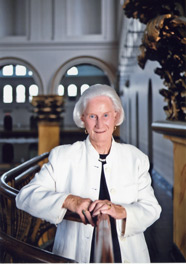 Beverly Willis, architect and advocate for women in architecture, died on October 1, 2023. She co-founded the National Building Museum in Washington, DC and served as a Founding Trustee of the Museum.
Beverly Willis, architect and advocate for women in architecture, died on October 1, 2023. She co-founded the National Building Museum in Washington, DC and served as a Founding Trustee of the Museum.
Beginning her career in San Francisco, she won acclaim in 1965 for 1890 Union Street Shops, a conversion of Victorian homes into retail use. This is considered one of the earliest adaptive-reuse successes, transitioning historic structures into modern purposes.
Moving to large-scale residential projects in the 1970s, Willis introduced the first computerized programing into large-scale planning and design. To better analyze proposed developments for their impact on the environment, she worked to create the Computerized Approach to Residential Land Analysis (CARLA). This software weighed factors like housing density, building types and costs, and Willis used it to site developments in California and Hawaii.
In 1983, Willis completed the San Francisco Ballet Building, her most recognizable project. Consulting the dancers, she adapted the design to better account for lighting and ventilation, based on their needs. This was the first building designed in the U.S. as a major ballet school.
Relocating her practice to New York City, Willis practiced professionally for a range of clients and founded the Beverly Willis Architecture Foundation in 2002, to acknowledge, cultivate, and value women’s contributions and achievements in architecture.
In 1976, Willis joined The Washington Post art and architecture critic Wolf von Eckhardt, architect Clothiel Woodward Smith, Smithsonian architecture historian Cynthia Fields, and attorney Herbert Franklin to create the National Building Museum. Housed in the former U.S. Pension Bureau’s Headquarters, four blocks from the National Mall, the museum’s mission is to inspire curiosity about the world we design and build. The Museum’s Beverly Willis Library opened in 2008 to honor Ms. Willis’s contributions to the Museum.
In 2019 Willis participated in the Museum’s oral history project. When asked what was particularly exciting about the early days of the Museum, she said “Well it’s really the whole sort of creation idea, […] because that’s the point where you can have ideas. You can discuss ideas. You can take action and there’s a very close connection to the meeting, the discussion, and the action, and that’s very satisfying.”
“The National Building Museum is indebted to Beverly Willis and her drive to preserve our historic home and create the National Building Museum”, said Aileen Fuchs, president and executive director of the National Building Museum. “Additionally, her life’s work to recognize, promote and empower women in architecture has had enduring positive impact in the field and in our built world.”
